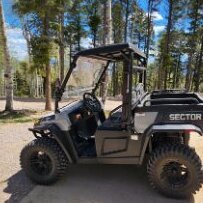COLEMAN UT400 Fuel indicator
-
Similar Topics
-
By didgeridoo
Hello, All! I've decided to replace the traction batteries in my 2018 Sector E1 with a 48V Lithium set. They may be expensive, but I figure the Discovery Dry Cell are, too. I am not looking for the max driving range, as I have never received near the brochured range to begin with, but a good mix of charge/ get work done/ charge is what I am expecting.
I have settled on the 48V EAGL kit from bigbattery dot com. Each battery pack provides 30Ah. The kit ships with a charger, as well. The packs would be physically connected in parallel (using a busbar) to one another, maintaining the 48V voltage, but together would be able to provide the amp draw the buggy pulls when going up hill or towing a rake (rated 320 max continuous Amps). This is in comparison to the serial connection the eight 6V lead batteries. Each of the EAGL batteries looks to have its own BMS; am I correct in thinking I will have to use their included charger rather than (simply) changing the onboard charger to lithium mode? The chemistry of the pack is LiFe PO4, for what it's worth. I haven't torn anything apart yet (to diagram), so I am not sure how the dash will interpret the AMP draw, but the kit I am looking at includes a dash mounted charge indicator.
If anyone has completed a similar conversion, do you have any tips? Specifically, how did you remove the original batteries, and how did you secure the new ones? I am guessing that almost any change from the stock batteries would involve at least some modifications. Any tips would be appreciated, especially things I may have failed to consider. Thanks!
-
By Smith5961
2020 550 Coleman. have a fault code 118 And I’ve replaced the sensor I have spark but still doesn’t crank
-
By SIO
Does anyone no how to to adjust these shocks. never had shocks with the fast and slow adjustments. But the main problem is it rides ruff. My bike came with the shocks set at 7 1/2" from center of nut to top of spring. The book calls for 5.5" front and 4.7" rear and they say max. Just want to make sure before moving them that far.
-
By hdtran
That's the question! Or, if you want to add details:
(a) How do you use the UTV? (roads? off-road to get to trees? etc.)
(b) If you are wearing a helmet--how frequently? What type of helmet?
My own answers: (a) Most of the time off-road to get to downed trees, cut the trees to logs and haul the logs back for splitting. (b) Very rarely, a ski helmet and not a motorcycle helmet.
-
By Alien10
A while back I was looking at an auction UTV plow and the mounting of it. Looked like it had an "H" bar with two pins that hooked into brackets on the front frame of the UTV. I have a bunch of 1/4" x2" angle iron, and some 2"x1/2" flat stock in the barn. I was thinking of welding up a bolt on implement mount that would provide 2 holes about 14" apart, that pins could be used to hook up an "H" frame for a plow or even a straight bar across with pins to hold it in place. The angle iron "A" would utilize the existing bumper mounting bolts front and bottom, and have the two channels "B" with holes for individual pins or one large bar across. Those channels would be welded to the ends of the angle iron.
Anyone ever try this for a front mount? It would be close to this one that is for sale on the net. It is supposed to fit a KFI plow mount.
-






Recommended Posts
Join the conversation
You can post now and register later. If you have an account, sign in now to post with your account.
Note: Your post will require moderator approval before it will be visible.